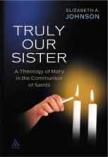Spirit-Filled Companion
With the publication of Truly Our Sister: A Theology of Mary in the Communion of Saints, Elizabeth A. Johnson has reached a challenging theological goal that she set for herself almost a decade ago. It was Johnson’s initial desire to write a book on Mary and include a chapter on the communion of saints. What emerged was an entire book on a feminist theological reading of a doctrine often misunderstood and forgotten in Catholic theology. The feminist reconstruction of Mary would have to wait until Friends of God and Prophets was completed. The long-anticipated work on Mary of Nazareth is now finished, and it was well worth the wait.
Probably no other figure in Christianity is more misunderstood, misconstrued and misinterpreted than Mary. At the same time she is deeply revered. The numerous layers of historical nuancing make it difficult to find the true Miriam of Nazareth, a Jewess who lived in Roman-occupied Galilee during the first century. It is Johnson’s quest to free this Jewish woman from the various projections and misconceptions placed upon her over the centuries.
Johnson, a professor of theology at Fordham University in New York City, is clear from the outset that her goal is to situate Mary within the community of saints and develop a theology of her significance within this community. In order to do this, she must first liberate this woman from the oppressive and incorrect understandings of patriarchy. Mary needs to be freed from an idealized vision of Christian perfection, from an image of feminine submissiveness and blind obedience and from a docility that portrays her yes as being spoken without thought or question. Mary has also often been viewed through an overly romanticized understanding of motherhood.
As I contemplated Johnson’s critique of what patriarchy has distorted in the life of this Jewish woman, I realized at a new depth that what has happened to the mother of Jesus has happened to many women within the Christian tradition. The “liberation” of Mary is so important because ultimately it will liberate the stories of us all. The author’s impressive comprehension of the method of feminist theology shines throughout the first six chapters of this work as she explains quite succinctly how some male theologians with good intentions have not helped the Marian situation by turning Mary into the ideal face of woman and the maternal face of God. A huge reconstructive task lay before Johnson, and the reader will discover that she was certainly up to the challenge. As usual, Johnson is clear that there are historical and theological precedents for speaking of Mary as “truly our sister.” Not only does Johnson’s theological reconstruction find its impetus in feminist work; it is rooted in the church’s tradition as well.
In the second half of Truly Our Sister, Johnson describes a world for us and locates Miriam of Nazareth in the historical moment in which she lived. How enlightening and freeing it is to visualize Miriam in her own land, among her own people. I was able to picture this woman fostering an observant Jewish household and participating actively in local village traditions. My favorite image from these chapters is that of Miriam making Sabbath preparations and lighting the Sabbath candles. Johnson does not give us the facile world of the glorious French princess in the celestial court. The research behind this section is extensive, and I was especially surprised to learn that not all Jewish women led oppressed religious lives. Johnson makes clear that there was great diversity in the status of first-century Jewish women.
The key chapters of this book are Chapters 10 and 11. Here the author sets free the dangerous memory of Mary through a biblical mosaic of her life as revealed in the 13 New Testament scenes where she speaks, takes action or plays a key role in the story. Johnson’s hermeneutics of suspicion reconstructs and transforms the world behind the text. As we look through the colored chips of Johnson’s mosaic, a life emerges: a life that is intelligent, contemplative, active, wounded and Spirit-filled. The reader receives wonderful insights about this friend of God and prophet. We are led through the many aspects of this woman’s life to the key moment of her Pentecost experience, when Johnson lovingly enfolds her into the community of believers.
It is difficult to find flaws in this work, but one might be that Johnson does not make sufficiently clear that women have found liberating elements in Mary for centuries, even though these women lived in pre-Vatican II times. It would be unfortunate if the reader came to believe that liberative work on Mary is confined to the last 50 years. I agree with Johnson that we must rediscover and renew the symbol of Mary for this generation, because the symbol of Mary functions for our faith. Significant recognition, however, still needs to be given to those women who, while being part of an immigrant church, looked to the mother of God as a source of freedom—and found it in her.
At the end of this work, as I read the well-known words of the Magnificat, I found myself quite moved. I reflected upon how this scholarly, well researched, beautifully written and theologically profound book propelled me back to a place and time over 25 years ago. On that day I stood before a statue of a young Jewish woman and saw in her tremendous freedom, an openness to grace and an integrity of Spirit. I needed reminding of what it was in this woman that propelled me forward. It is my hope that the readers of this book will come away from it as I have, knowing deep within themselves that Miriam of Nazareth always is and always will be truly our sister.
This article also appeared in print, under the headline “Spirit-Filled Companion,” in the June 9, 2003, issue.








